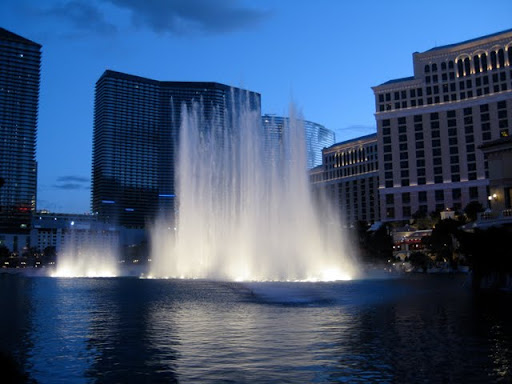LAS VEGAS, NEV – Walking up from our hotel to the strip in search of a place to eat last night, battered by neon and flashing lights, my dinner companion commented ruefully on how distant we were from nature. I suppose you could say that in the middle of any city, but in Las Vegas the idea resonates.

Bellagio Fountain, April 2010
I know I went for the cheap water wonk gag with the Bellagio Fountain thing the other day, but it carries symbolism well beyond the acre feet involved. On the way past the fountain last night after dinner, I could have sworn I saw a couple of ducks in the shadows against the faux Italianate villas, so I went back this evening before dark for a better look. Sure enough, five mallards. They looked completely out of place.
For an alternative take on the Las Vegas water story, I found my way this afternoon to the wetlands along Las Vegas Wash on the east end of town. Clark County’s sewage treatment plant dumps into the wash, which leads down to Lake Mead. It’s an example of a familiar method of western water accounting. Vegas withdraws water from Mead. Some of it ends up on lawns and gardens and evaporates into the dry desert air. Some of it ends up flushed down to the sewage treatment plant and thence on to Lake Mead. Vegas gets a return credit for that water against its total allotment.
As a byproduct of this accounting methodology, you end up with a river running year ’round down Las Vegas Wash, which before human intervention would have only been wet during flash floods. When you add water, nature happens. I saw herons and egrets and an osprey circling overhead, all birds that live around water. They never would have made a place like Las Vegas Wash their home before the advent of modern sewage treatment plants and return flow credits.
An interagency group manages the Las Vegas Wash with facilities intended to improve water quality on its way to Lake Mead, primarily by slowing it down. A series of weirs have created spectacular wetlands, a rare commodity in the desert. Hence the great blue herons. The people doing the project understand the side benefit going on here. They divert some of the water into a wetlands park with a wheelchair-accessible 1.5 miles of walking trails, little ponds and groves of trees and wonderful marsh habitat. They’ve also built trails out to the weirs along the main wash.
It’s gorgeous. The birds were fabulous. I counted 25 species on my walk, 13 of them water birds. Compare that to the five mallards at the Bellagio Fountain.
But is it nature?


Seems like ‘relic species’ to me.
(http://www.amazon.com/End-Wild-Boston-Review-Books/dp/026213473X)
Is it nature?
Yes and no.
England in its natural state, i.e. pre humans, is a dense forest not rolling lawns and fields. It has been claimed that
1. There is no nature left. Humans have changed the entire planet.
2. Nature is what is. Humans killing the large mammals in America, asteroids, and the great oxygenation event (when certain organisms poisoned all the rest by producing lots of free oxygen) are all natural. Nature is not static.
So, is it nature? Pick your belief system. Either we have not had a natural system in the last 200 million years (3 billion years?) or we always have one; it just changes.
John,
Good question. Now think about the Salton Sea and re-ask the question.
Pingback: High good, low bad. Lake Mead elevations April 2010 | Chance of Rain
If one accepts that humans are part of nature, then it follows that everything we do is as well.
George –
It is true that if one accepts your premise, then your conclusion follows. But I believe you can best understand words’ meanings by seeing how they are used in practice. If we accept your argument, then my car is nature, and that seems an abuse of how we all use the word in practice, to rob the word of its useful meaning. My friend was saying something meaningful when he observed how distant downtown Vegas was from nature. (In fact, my trusty Random House explicitly defines “nature” as the bits surrounding and existing independently from humans.)
What’s interesting to me here is the fissure exposed by the language – the bits we think of as “nature”, in the “independent from humans” sense that are in fact human constructs.
Pingback: Water in the desert: not exactly nature, but close : jfleck at inkstain